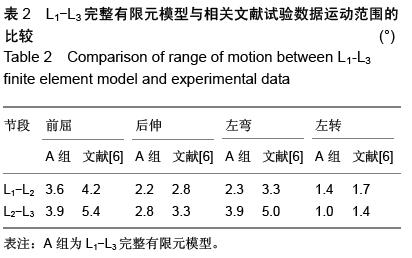| [1] 陈华星,杨圣,芦健民,等.有限元分析显微镜下不同比例髓核摘除后的腰椎力学特征[J].中国组织工程研究, 2014, 18(17):2659-2666.[2] 张兰凤,董黎敏,王永清,等.新型人工腰椎间盘置换的三维有限元模型[J].中国组织工程研究, 2013,17(30): 5477-5482.[3] 荀福兴,刘雄,张美超.材料属性分配梯度对椎体有限元模型力学性能的影响[J]. 医用生物力学, 2013,(4): 39-42.[4] Plaats AVD, Veldhuizen AG, Verkerke GJ. Numerical Simulation of Asymmetrically Altered Growth as Initiation Mechanism of Scoliosis. Ann Biomed Eng. 2007;35(7):1206-1215. [5] Ibarz E, Herrera A, Más Y, et al. Development and kinematic verification of a finite element model for the lumbar spine: application to disc degeneration. Biomed Res Int. 2013;2013:705185-705185.[6] 刘延东,毛景松,石先明,等.不同载荷下腰1椎体内应力分布规律的有限元分析[J].中国脊柱脊髓杂志, 2014,24(9): 822-827.[7] 李伟,张宏,曹丽君,等.脊柱腰段正常及骨质疏松三维有限元数字模型的建立[J].中国组织工程研究,2013,17(9): 1521-1526.[8] Polikeit A, Ferguson SJ, Nolte LP, et al. Factors influencing stresses in the lumbar spine after the insertion of intervertebral cages: finite element analysis. Eur Spine J. 2002;12(4):413-420.[9] Goel VK, Monroe BT, Gilbertson LG, et al. Interlaminar shear stresses and laminae separation in a disc. Finite element analysis of the L3-L4 motion segment subjected to axial compressive loads. Spine. 1976; 20(6):689-698.[10] Ding JY, Qian S, Wan L, et al. Design and finite-element evaluation ofa versatile assembled lumbar interbody fusion cage. Arch Orthop Trauma Surg. 2010;130(4):565-571.[11] Song C, Li XF, Liu ZD, et al. Biomechanical assessment of a novel L4/5 level interspinous implant using three dimensional finite element analysis. Eur Rev Med Pharmacol Sci. 2014;18(18):86-94. [12] Duan Y, Wang HH, Jin AM, et al. Finite element analysis of posterior cervical fixation. Orthop Traumatol Surg Res. 2015;101(1):23-29.[13] 李钦亮,刘艺,储朝明,等.伤椎椎弓根置钉治疗胸腰椎压缩性骨折的三维有限元分析[J].中国组织工程研究与临床康复,2011 15(39): 7226-7229. [14] 马立敏,周烨,张余,等.伤椎椎弓根螺钉内固定治疗胸腰段椎体压缩骨折的三维有限元分析[J].中国数字医学, 2013, (10):54-57.[15] 刘建航,靳安民,段扬,等.腰椎ISOBAR TTL半坚强内固定系统的三维有限元分析[J]. 中国现代医学杂志, 2013, (12):101-104. [16] 闫广奎,叶君健.有限元分析法在腰椎生物力学研究中的应用[J].中国组织工程研究, 2012, 16(22): 4117-4120. [17] Gómez FS, Lorza RL, Bobadilla MC, et al. Study of Different Biomaterials for Artificial Lumbar Disc Prosthesis Using FEM. Appl Mech Mat. 2015; (2015): 483-487. [18] Yamamoto I , Panjabi MM, Crisco T, et al. Three-dimensional movements of the whole lumbar spine and lumbosacral joint. Spine. 1989;14(11): 1256-1260. [19] 宋元进,蔡锦方.胸腰段骨折不同固定方式的有限元分析[J].中国组织工程研究与临床康复, 2009, 13(52):10269- 10273. [20] 赵文志,苏晋,陈秉智,等.有限元分析在腰椎生物力学研究中的应用[J].中国组织工程研究与临床康复, 2009, 13(30): 5927-5930..[21] Charosky S, Moreno P, Maxy P. Instability and instrumentation failures after a PSO: a finite element analysis. Eur Spine J. 2014;23(11):2340-2349.[22] Moramarco V, Perezd PA, Doblare M. An accurate validation of a computational model of a human lumbosacral segment. J Biomech. 2010;43(2): 334-342. [23] Henao J, Aubin CÉ, Labelle H, et al. Patient-specific finite element model of the spine and spinal cord to assess the neurological impact of scoliosis correction: preliminary application on two cases with and without intraoperative neurological complications. Comput Methods Biomech Biomed Engin. 2016;19(8): 901-910. [24] Clin J, Aubin CÉ, Parent S. Biomechanical simulation and analysis of scoliosis correction using a fusionless intravertebral epiphyseal device. Spine (Phila Pa 1976). 2015;40(6):369-376.[25] Wu DM, Zhang LT, Zhao J. Biomechanical Analysis of Cervical Finite Element Model. Appl Mech Mat. 2013; 273:845-850.[26] Wang W, Zhang H, Sadeghipour K, et al. Effect of posterolateral disc replacement on kinematics and stress distribution in the lumbar spine: a finite element study. Med Eng Phys. 2013;35(3):357-364.[27] 陈浩,张锦洪,贺增良.脊柱胸腰段三维有限元模型的建立与验证[J].江苏大学学报:医学版, 2014, 24(1):72-75.[28] 马凯,姜长明,王以进.腰椎后部韧带结构生物力学实验研究与临床意义[J].医用生物力学,1998, 13(2):80-85. [29] Okubo T, Mori K, Wadano Y, et al. Prediction of compression fracture risk of lumbar vertebra using a X-ray CT-based finite element method. J Japan Acad Heal Sci. 2013;16:90-98. [30] 项嫔,都承斐,赵美雅,等.全腰椎有限元模态分析[J]. 医用生物力学, 2014, 29(2):154-160.[31] Parker JW, Lane JR, Karaikovic EE, et al. Successful short-segment instrumentation and fusion for thoracolumbar spine fractures: a consecutive 41/2-year series. Spine(Phila Pa 1976). 2000;25(9): 1157-1170.[32] Iguchi T, Kurihara A, Nakayama J, et al. Minimum 10-Year Outcome of Decompressive Laminectomy for Degenerative Lumbar Spinal Stenosis. Spine. 2000; 25(14):1754-1759.[33] Oh JK, Dong YL, Kim TY, et al. Thoracolumbar extradural arachnoid cysts: a study of 14 consecutive cases. Acta Neurochirurgica. 2012;154(2):341-348.[34] Kawaguchi Y, Kanamori M, Ishihara H, et al. Clinical and radiographic results of expansive lumbar laminoplasty in patients with spinal stenosis. J Bone Joint Surg. 2005;87 suppl 1(8):1698-1703.[35] Nasser R, Yadla S, Maltenfort MG, et al. Complications in spine surgery. J Neurosurg Spine. 2010;13(2): 144-157.[36] 张光铂.浅谈脊柱内固定的应用与植骨融合[J].中国脊柱脊髓杂志,2002, 12(5): 325.[37] Deligianni D, Korovessis P, Baikousis A, et al. Factor Analysis of the Effectiveness of Transfixation and Rod Characteristics on the TSRH Screw-Rod Instrumentation. J Spinal Disord. 2000;13(1):50-57.[38] 赵国辉,蒋西嘉,李海波,等.经伤椎椎弓根植骨加椎弓根螺钉复位内固定治疗胸腰椎骨折的效果[J]. 实用临床医药杂志, 2015,19(24):152-153.[39] Adachi K, Futami T, Ebihara A, et al. Spinal canal enlargement procedure by restorative laminoplasty for the treatment of lumbar canal stenosis. Spine J. 2003; 3(6):471-478.[40] 李双平.后路钉棒系统内固定结合后外侧植骨治疗胸腰段脊椎骨折34例[J]. 中国临床研究, 2013, 26(3): 252-253.[41] 杨隆,谢水安,孙世伟,等.后路钉棒系统内固定结合后外侧植骨用于胸腰段脊椎骨折的疗效观察[J].当代医学, 2013, 19(10):117. |
.jpg)

.jpg)

.jpg)
.jpg)
.jpg)